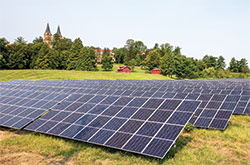Monastery rooted in tradition looks forward in its use of renewable energy

Solar panels sit in a field at the base of the hill on which Saint Meinrad Archabbey and its seminary are located in St. Meinrad. (Photo courtesy of Saint Meinrad Archabbey)
By Sean Gallagher
ST. MEINRAD—Saint Meinrad Archabbbey is deeply rooted in tradition. Founded in 1854, its Swiss motherhouse is more than 1,000 years old.
Yet the monks of Saint Meinrad have always been forward-looking in using the resources with which they have been blessed.
In 1890, they had a power plant built on their campus to provide electricity for the monastery, its seminary and other buildings.
Later developments included the monastic community developing a water utility and wastewater treatment facility for itself and the adjacent town of St. Meinrad.
This innovation continues today with the monastery having installed more than 3,000 solar panels along State Road 545 at the base of its campus in Spencer County.
All of this progress, Benedictine Archabbot Kurt Stasiak noted, flows from Saint Meinrad’s faithful following of the 1,500-year-old Rule of St. Benedict, which calls monks to regard tools used in secular work “as sacred vessels of the altar.”
“Every generation of monks, as Benedict encourages the abbot to do, brings out some of the old and some of the new,” said Archabbot Kurt, who has led Saint Meinrad since his election in 2016. “They try to keep pace with the progress being made to support and strengthen some very traditional values.”
Progress made in technology related to renewable energy made the solar panel project possible for the monastic community. It had investigated a potential solar panel field in the past, but the costs were too high. In the past eight years, though, the cost of solar panels has decreased by 60%, said Mark Hoffman, Saint Meinrad’s physical facilities director,
“That really solidified it,” Hoffman said. “But, in the end, it was a good thing to do for the environment.”
He also noted that the solar panel initiative follows upon other efforts at Saint Meinrad aimed at lessening its carbon footprint.
The campus has moved entirely to LED lighting. And a geothermal heating and cooling system is now in place for the monastery and its Our Lady of Monte Cassino Shrine.
Hoffman said that the change to LED lighting and the installation of the solar panel field will reduce Saint Meinrad’s electrical costs by 30% per year—an annual savings of more than $200,000.
“It’s a fantastic opportunity,” he said. “ … We’re going to pay for this in 12 years or less.”
That’s especially attractive since the panels in the solar field are guaranteed to produce for 25 years at least 80% of their initial electricity output.
The annual utility savings produced by the various conservation and renewable energy initiatives will be put into a fund to support future efforts to be good stewards of creation.
With its seminary forming men for the priesthood across the country and around the world and its close ties to other religious communities, parishes and Catholic schools, Archabbot Kurt hopes that Saint Meinrad’s energy-saving efforts will influence others to do the same.
“I believe we are giving a good and needed example,” he said. “One nice thing about the solar panel field is that it is so obvious. You see it every time you drive by, so it is in a sense an active advertisement in real time of our interest in being good stewards of creation.”
Hoffman agrees.
“The world’s need for environmental sustainability is increasing,” he said. “Implementing strategies to reduce our impact on the Earth are important for institutions. Our hope is that we can be source of inspiration for others to take the steps be good stewards of the land.”
Although the solar field initiative will benefit the environment and Saint Meinrad’s utility expenditures, Archabbot Kurt sees them all interwoven with and flowing from the faith of the 167-year-old monastic community.
“We believe—we hope—that God will continue to bless us and our work for the next generations,” he said. “We want to cooperate with those blessings and not simply enjoy them while taking a back seat when it comes to what we can contribute.” †
Related story: Cardinal Ritter integrates new solar panels into science, theology classes
